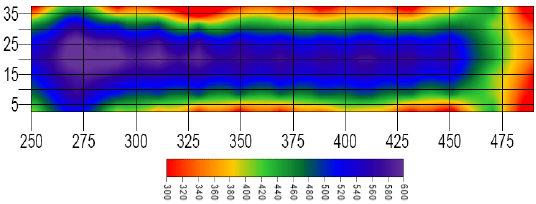



Keeping Birds Cool in Hot Weather
By Brian D. Fairchild, Extension Poultry Scientist and Michael Czarick, Extension Engineer, the University of Georgia Cooperative Extension Service. Birds that are heat stressed have increased mortality, reduced weight gain and poor feed conversion.As warmer weather approaches, the threat of heat stress increases. Poultry producers need to anticipate this and have housing and management procedures ready to respond. Effective summertime management is crucial for growers to achieve maximum weight gains and optimum feed conversion while preventing bird loss due to heat exhaustion. The following is a summary of some steps to be taken during hot weather ventilation. The month and year of the full newsletter on each of these topics are listed in parenthesis at the end of each section and can be found at www.poultryventilation.com.
Air Speed Distribution
Air speed is the most effective way to cool birds in hot weather and ensure optimum performance. Modern houses are designed for air speeds of 500 to 600 ft/min. In theory, the distribution of air speed should be equal across the length of the house. However, interior side wall construction and equipment placement have been shown to significantly impact wind speed distribution down the length of the house. Solid side wall houses with a smooth surface have better wind speed distribution versus those with posts. Air speed along the side walls has been found to be as much as 200 ft/min slower than the air speed in the middle of the house.
(April 2004; June 2004)

Figure 1. Air speed distribution in a 40’ x 500’ broiler house with stud wall construction, curtain sided and forced air furnaces located on the bottom wall.
Bird Distribution
When more birds are in one end of the house than the other bird performance is reduced. In addition to the increased competition for water and feeder space, the heat load in the house can be very different from front to back. Timely installation of migration fences and use of appropriate fence materials are key to maintaining bird uniformity down the length of the house. Not all materials make good migration fences. While most materials will do a good job of minimizing bird migration down the house, they can cause dead air spots on the downwind side of the fence, resulting in heat stressed birds and increased mortality. Plywood fences resulted in the largest dead spot whereas the ten inch black plastic drain pipe has a smaller yet still significant dead spot. Wire shelving material works best with no dead spot and relatively no wind resistance.
(May 2005; June 2005)

Figure 2. Plywood migration fence in a commercial broiler house. A 5 ft strip of hot birds can be observed on the downwind side (left panel) of the fence compared to the upwind side (right panel).
Nighttime Cooling
During hot weather, night-time bird management is just as important as the daytime management. Even in the best broiler houses, some heat build up is going to occur on hot days. During that time, bird body temperature may rise, but does not increase enough to result in panting. It is these days, as well as days that birds end up panting that nighttime cooling can have enormous impacts on bird performance. Just because birds are not panting does not mean that they are not hot. In addition to that, some people feel that when temperatures drop at night, it is an opportunity to reduce the number of fans running for utility savings. However, the small amount saved on the electricity bill will not compare to what is lost in performance. A recent study conducted by the USDA in Mississippi demonstrated the importance of running fans at night. The study showed that providing 300 ft/min was better than no fans running but stated that 550 ft/min provided the best results with increased weight gain and better feed conversion. The money it costs to run the fans during the last two weeks should be considered a good investment. The increased weight gain and better feed conversion will definitely yield a good return on that investment.
(July 2003; July 2005; August 2005)
Equipment and House Maintenance
The whole ventilation system is dependent on the fans which create the negative pressure to pull air into the house. Fan belts and pulleys should be checked routinely because as they wear down, fan blade speed and subsequent movement will be reduced. Fan shutters should be cleaned regularly. Dirty shutters will make it harder for the fans to move air, reducing their efficiency. Testing house static pressure is just as important for hot weather as it is for cold weather. Provided that the fans are in good repair, house static pressures that are low after conducting a test indicate air leakage. Any air leaking through cracks or holes is not being pulled through cool cell pads. This will result in larger temperature buildups from front to back and hurt overall house performance, as well as result in poor bird uniformity. The evaporative cooling system should receive regular maintenance as it adds to the effectiveness of cooling birds by tunnel ventilation. Dirty pads will restrict air flow making it harder for the fans to pull air into the house. Not only will this hurt fan efficiency and increase fan wear and tear, but bird cooling will be significantly reduced.
(June 2001; July 2001; April 2002; May 2004, July 2004; November 2004; May 2006; November 2006)
Good management and routine maintenance are important components of hot weather broiler production. Simple steps and attention to detail will ensure that houses are running optimally and that birds are managed correctly.








